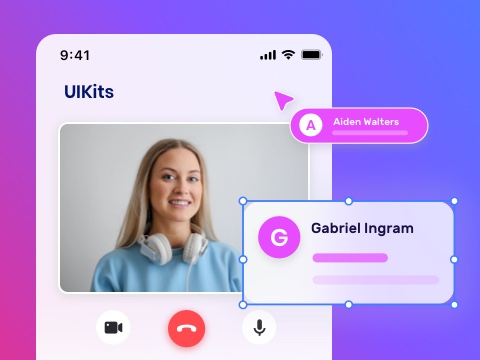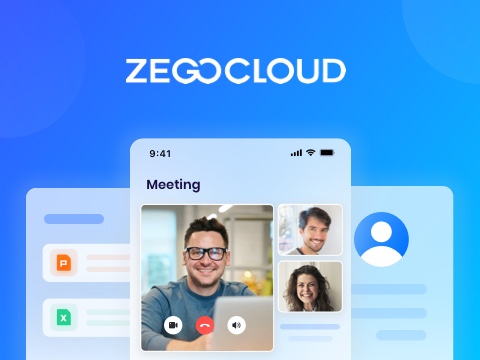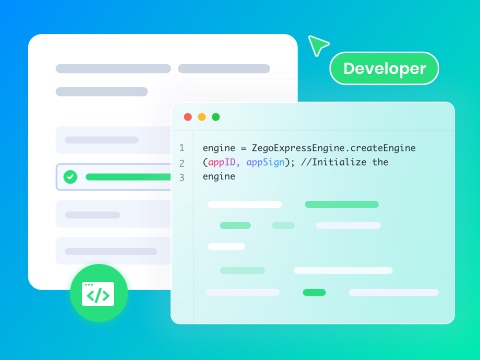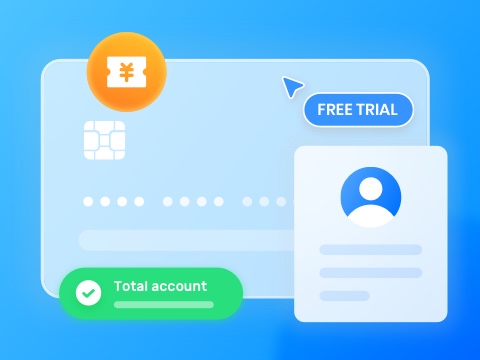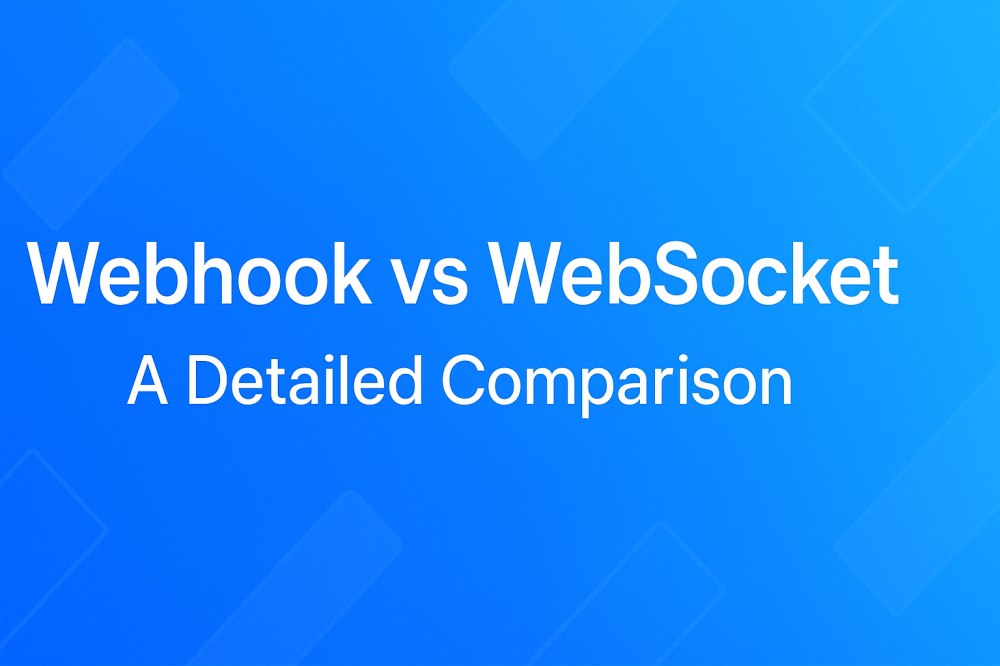As we all know, the need for instant data sharing is growing fast as apps become more connected and dynamic every day. Thus, many developers and teams compare Webhook vs WebSocket to choose the best method for sending real-time messages easily. Both help apps communicate quickly, but they serve different goals based on your project’s needs. Hence, this article will explain their meanings and major differences between them.
What are Webhooks?
Webhooks are simple tools that let apps talk to each other when something important happens in real time. They work by sending small data messages from one app to another through a web link called a URL. For example, when someone signs up on a website, the app can send that info to another system right away.
Moreover, users don’t need to keep checking for changes, as Webhooks only send data when something triggers them to act. In the Webhooks vs WebSocket comparison, Webhooks are better for one-way alerts where apps don’t need to stay connected. Anyhow, they are easy to build and manage, which makes them a famous choice for beginners and web developers alike.
Pros and Cons of Webhooks
Before you choose between WebSocket vs Webhook, it’s important to understand where Webhooks work well and where they may not. Below, we will explore some pros and cons to help you pick the right method based on your expected tasks:
Pros
- You can use Webhooks in many popular tools like GitHub or Slack to automate everyday tasks.
- They reduce the need for checking updates repeatedly, which saves server power and keeps apps efficient.
- Webhooks only send data when needed, which helps lower the amount of internet traffic and resource usage.
- Developers can link one Webhook to many tools simultaneously, which is great for teams working across different apps.
Cons
- When the sending app is offline during an event, the data won’t be delivered or recorded on the other side.
- Webhooks usually don’t retry failed messages many times, which can cause important updates to be completely missed.
- They only send data one way, so you can’t have two-way communication or replies using a basic Webhook setup.
How Webhook Works?
To better understand WebSockets vs Webhooks, you should also know how Webhooks send data between two different apps. So, this section will explain the process of how Webhooks work when an event takes place in one system:
1. Registration
It is what happens inside the source app, like a user signing up or placing an order. Besides, this event acts as a signal that tells the system it’s time to send data somewhere else. Moreover, the app watches for this event and prepares to send information to another app as soon as it takes place.
2. Event Trigger
When the event happens, the Webhook activates on its own without needing any manual action or repeated checks. At this time, it instantly prepares a message with the event details and gets ready to send it to a set web address. So, this automatic trigger makes Webhooks fast and efficient for sharing updates or alerts between apps in real time.
3. HTTP Request Delivery
Once the Webhook is fired, the event data is sent to a target URL, which is a web address. Consequently, the given URL is associated with the app or system in which the information is required. Moreover, the data is typically transmitted in a simple format such as JSON, which enables the receiving app to comprehend and consume it immediately to act upon it further.
4. Data Processing
Once the data arrives in the target app, it reads the message and takes some action based on its content. In addition, this could be something like updating a user profile, adding an entry into a record, or sending a notification. In the Webhook vs WebSocket comparison, Webhooks send data once, while WebSockets keep a connection open for a continuous conversation.
5. Response Completed
When the receiving app processes the data, it quickly performs the final task, like updating a status or sending a reply. Plus, this action happens right after the Webhook delivers the message, with no need for waiting or manual steps. Thus, the result is an automatic workflow that keeps apps connected and users updated in real time.
Use Cases of Webhooks
Many people also look at where Webhooks are actually used to better understand the Webhooks vs WebSockets debate. Thus, the following parts cover a few real examples to show how Webhooks support tasks across different services:
1. Instant Alerts and Notifications
Webhooks send instant messages whenever orders are placed or delivered through e-commerce platforms to keep customers informed. Alongside that, they also help teams act fast during incidents by sending alerts to tools like Slack. So, it shows how live data can be shared with speed and efficiency across various platforms and niches.
2. External Services Integration
They allow messaging apps like MailChimp to update email delivery status and engagement reports directly from external platforms. Moreover, they even connect CRM tools or chat apps to send messages or create tasks when problems occur. As a result, these connections save effort and ensure that all tools stay in sync without constant checks.
3. Payment Automation
In payment gateways like PayPal, Webhooks alert systems to update records or notify users whenever the payment succeeds or fails. Besides, they even trigger invoice creation or order fulfillment, which removes manual processing. While comparing WebSockets vs Webhooks, this is useful for online stores and billing platforms that need instant transaction updates.
4. Software Development
Webhooks trigger automatic tests or deployments when code is pushed to GitHub or other code hosting platforms. Additionally, they notify teams through chat apps when code changes, issues, or pull requests are created in the system. Hence, these actions help development teams speed up work and stay updated on what’s happening across their projects.
5. IoT and Home Automation
When a smart device detects movement or input, Webhooks can trigger lights, notifications, or other actions without delay. In addition, they help connect various devices like doorbells or alarms to work together using real-time event updates. Thus, it ultimately lets users automate everyday tasks at home or in the office, creating smooth, connected smart device experiences.
What are WebSockets?
In the WebSocket vs Webhook comparison, WebSocket keeps a connection open between your app and the server at all times. Unlike regular HTTP, it doesn’t close after sending data, as it allows ongoing binary messages through one connection. Besides, this setup is useful for apps that need real-time updates, like messaging systems or multiplayer games.
Furthermore, they use fewer system resources by avoiding repeated requests, which makes it more efficient than traditional polling methods. Both the app and server can send or receive data at any moment, without waiting for each other first. Plus, it works over standard internet ports like 80 and 443, so it connects smoothly even behind firewalls or proxies.
Pros and Cons of WebSocket
Users also need to understand what WebSocket does well and where it may fall short. Hence, the following section explains the main strengths and limits of WebSocket in this WebSockets vs Webhooks debate:
Pros
- Since the connection stays open, it uses fewer resources compared to opening and closing HTTP connections all the time.
- Most new web browsers support WebSocket, so developers don’t have to worry about installing extra tools or plugins.
- After setup, data flows quickly between client and server without waiting for repeated requests like HTTP.
- It can also handle many users at once by keeping the connection bidirectional without much stress on the server.
Cons
- Setting up WebSocket can be harder than a normal website because it needs special coding for connection control.
- It does not work well in old browsers, so it may not be suitable for users with outdated devices.
- Finding and resolving issues with WebSocket traffic is more difficult than with regular site traffic or HTTP calls.
How WebSocket Works?
To know how it works, it’s helpful to see how it stays open for live data sharing. Below, we will explore a detailed process to better understand the Webhook vs WebSocket comparison:
1. Client Initiates
The process begins when the client sends a GET request using HTTP with special headers to the server. Plus, these headers include signals like “Upgrade: websocket” to request a switch from HTTP to WebSocket. So, this request tells the server that the client wants a two-way, live communication instead of the regular web browsing method.
2. Server Responds
In addition, the server reviews the client’s request and replies only if it accepts switching to WebSocket. Alongside that, it sends back a status “101 Switching Protocols” with matching headers to confirm the upgrade. Besides, it includes a special key response that proves the server agrees to start real-time communication with the client.
3. Protocol Upgraded
When the server confirms the switch, the connection upgrades from HTTP to WebSocket for live communication. Now, both client and server exchange data using WebSocket frames, not regular HTTP messages. Plus, it shows the key difference in Webhook vs WebSocket, where WebSocket allows continuous bidirectional connections while Webhooks do not.
4. Two-Way Communication
After the protocol upgrade, the connection supports smooth binary messaging between client and server. So, both sides can now send or receive data anytime without waiting for the other. Hence, this real-time exchange continues as long as the connection stays open and stable between both devices.
5. Connection Closes
Either the client or server can end the connection by sending a special “close” signal or frame. As a result, this action lets both sides shut down the connection politely without data loss or confusion. After closing, no more messages are exchanged, and the WebSocket session officially ends on both ends.
Use Cases of WebSocket
When comparing WebSocket vs Webhook, WebSocket fits better for a continuous bidirectional connection. For further understanding, this part covers some common use cases where it is utilized:
1. Messaging Platforms
WebSocket is widely used in live chatting platforms or apps to send and receive messages instantly. It also avoids delays, reduces server load, and saves data by keeping an effortless connection. Unlike polling, which checks the server often, WebSocket lets users see typing alerts and new messages in real-time.
2. Online Gaming
It is also ideal for online multiplayer gaming that needs fast and smooth performance. Moreover, WebSocket allows game servers and players to share updates instantly. This also helps gamers enjoy fair and live gameplay effortlessly without overloading the server.
3. Live Location Tracking
In addition, apps, like cab or delivery services, rely on real-time updates to show accurate positions. Here, WebSockets help by sending location changes instantly without waiting. Along with that, this ultimately helps keep users or customers updated with minimal delays.
4. Collaborative Tools
Many tools, like shared documents on Google Docs, need instant updates to reflect every user’s action. At this particular time, WebSocket enables this by maintaining an open chat that pushes changes instantly to all participants. In the debate of WebSocket vs Webhook, WebSocket clearly wins as Webhooks can’t deliver a low-latency bidirectional connection.
5. Remote Monitoring
Such apps in healthcare rely on WebSockets to instantly send patient vitals and updates without any delays. Plus, this low-latency connection helps doctors track conditions in real-time and even improve response time in emergencies. So, compared to the traditional method, WebSocket ensures data and effortless data flow in any situation.
WebSocket vs Webhook: Key Differences
This section further compares WebSocket vs Webhook to help you see how they differ side by side in the table below:
| Feature | Webhook | WebSocket |
|---|---|---|
| Connection Type | One-way connection triggered by specific events | Persistent two-way connection that stays open |
| Data Flow Direction | Only server to client or client to server (not both) | Bidirectional – both client and server can send and receive data |
| Real-Time Capability | Near real-time (only when triggered) | True real-time with continuous updates |
| Trigger Mechanism | Event-based – data sent only when an event occurs | Continuous stream – no event needed to push data |
| Server Load | Lower load due to event-based calls | Higher load when managing many open connections |
| Ease of Setup | Simple to configure and implement | Requires a more complex setup and handling |
| Browser Support | Works on all modern and legacy systems | Needs modern browsers or support for the WebSocket protocol |
| Retry Mechanism | May not retry failed delivery unless manually coded | Built-in handling with fewer failures during active connection |
| Best Use Cases | Occasional, event-driven, one-way notifications, | Continuous, real-time, bidirectional communication |
| Resource Efficiency | Efficient for occasional updates | Efficient for constant, heavy data exchange |
ZEGOCLOUD: A Real-Time SDK Built on WebSocket
For developers who want to build apps that send data quickly and keep users connected, try ZEGOCLOUD. It helps create real-time apps with various APIs and SDKs like voice, video, and live messaging, embeddable in a few lines of code. Thus, you can send and receive data instantly because it uses WebSocket for fast and stable connections. Besides, ZEGOCLOUD’s SDKs come with 20+ UIKits so developers can build features without designing from scratch.
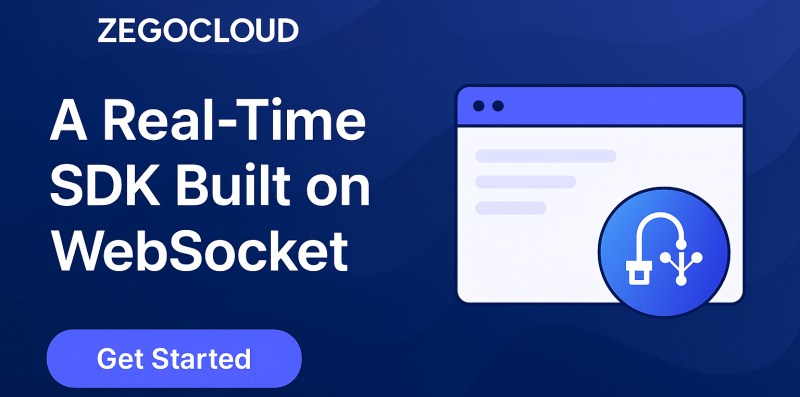
Furthermore, the platform supports HD video quality of up to 4K resolution for a clear participant’s interaction. At the same time, the audio calling feature comes with a 48kHz sampling to make calls and live streams engaging for users. Its noise reduction also helps improve audio in group calls or live broadcasts without background sounds. In addition, ZEGOCLOUD offers ultra-low delays under 300ms in sending data, which is key in interactions.
Its native chat tools even allow smooth text messaging inside any app, like customer service or gaming chats. Moreover, users can create shared whiteboards or group workspaces for remote teams or online classes. When comparing Webhooks vs WebSockets, ZEGOCLOUD shows the real value of WebSockets in real-time apps. It even supports cross-platform use, and you can opt for it for over 15,000+ devices easily.
Conclusion
In conclusion, choosing between Webhook vs WebSocket depends on your app’s data needs and connection style. Additionally, Webhooks are great for quick alerts, while WebSockets support live and bidirectional updates.
As a result, both have unique benefits based on your usage preferences. Besides, if you want to build your messaging or streaming platform on WebSockets, you should use ZEGOCLOUD, as it offers built-in SDKs and APIs to address this need.
FAQ
Q1: Is a webhook the same as a WebSocket?
No, they are quite different. A webhook is a one-way communication method where the server sends data to another system when a specific event occurs. In contrast, a WebSocket creates a persistent connection that allows both the client and server to exchange data continuously in real time.
Q2: Is a webhook push or pull?
A webhook uses a push approach. When something happens on the server side, it immediately sends the data to a preconfigured URL. There is no need for the client to keep checking for updates.
Q3: What’s the difference between a webhook and WSS?
A webhook is triggered by events and sends data only when something specific happens. WSS, which refers to WebSocket over TLS, allows for ongoing two-way communication between client and server. Webhooks are suitable for occasional updates, while WSS is better for real-time interactions such as chat applications or live monitoring.
Q4: Are WebSockets becoming obsolete?
Not really. While some newer technologies like HTTP/3 or WebTransport are being adopted in specific scenarios, WebSockets are still widely used. They continue to be a reliable choice for building real-time features where low latency and two-way communication are important.
Let’s Build APP Together
Start building with real-time video, voice & chat SDK for apps today!


